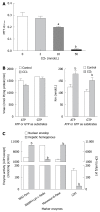Mechanism underlying carbon tetrachloride-inhibited protein synthesis in liver
- PMID: 20712057
- PMCID: PMC2923770
- DOI: 10.3748/wjg.v16.i31.3950
Mechanism underlying carbon tetrachloride-inhibited protein synthesis in liver
Abstract
Aim: To study the mechanism underlying carbon tetrachloride (CCl(4)) -induced alterations of protein synthesis in liver.
Methods: Male Sprague-Dawley rats were given CCl(4) (1 mL/100 g body weight) and (3)H-leucine incorporation. Malondialdehyde (MDA) level in the liver, in vitro response of hepatocyte nuclei nucleotide triphosphatase (NTPase) to free radicals, and nuclear export of total mRNA with 3'-poly A(+) were measured respectively. Survival response of HepG2 cells to CCl(4) treatment was assessed by methyl thiazolyl tetrazolium. Km and Vmax values of nuclear envelope NTPase activity in liver of rats treated with CCl(4) were assayed by a double-reciprocal plot.
Results: The protein synthesis was inhibited while the MDA level was significantly increased in liver of rats treated with CCl(4). In addition, CCl(4) decreased the NTPase binding capacity of nuclear envelope (Km value) in cultured HepG2 cells. Moreover, in vitro ferrous radicals from Fenton's system suppressed the NTPase activity of liver nuclear envelope in a dose-dependent manner. Down-regulation of the nuclear envelope NTPase activity indicated a lower energy provision for nucleocytoplasmic transport of mRNA molecules, an evidence in CCl(4)-treated HepG2 cells correspondingly supported by the nuclear sequestration of poly (A)(+) mRNA molecules in morphological hybridization research.
Conclusion: Inhibition of mRNA transport, suggestive of decreased NTPase activity of the nuclear envelope, may be involved in carbon tetrachloride-inhibited protein synthesis in liver.
Figures




References
-
- Masuda Y. [Learning toxicology from carbon tetrachloride-induced hepatotoxicity] Yakugaku Zasshi. 2006;126:885–899. - PubMed
-
- Quan J, Yin X, Xu H. Boschniakia rossica prevents the carbon tetrachloride-induced hepatotoxicity in rat. Exp Toxicol Pathol. 2009:Epub ahead of print. - PubMed
-
- Agutter PS, McArdle HJ, McCaldin B. Evidence for involvement of nuclear envelope nucleoside triphosphatase in nucleocytoplasmic translocation of ribonucleoprotein. Nature. 1976;263:165–167. - PubMed
Publication types
MeSH terms
Substances
LinkOut - more resources
Full Text Sources

